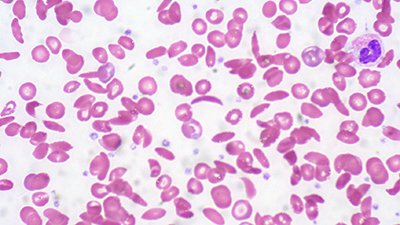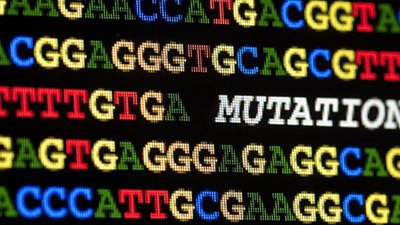
Link Between Sickle-Cell and Malaria Resolved
Mysterious malarial link to sickle-cell mutation resolved.
News Source
- Nature: “Sickle-cell mystery solved”
Back in 1954, British geneticist Anthony Allison reported people carrying sickle-cell trait were better able to survive malaria. No one knew why. But sickle-causing hemoglobin results from a mutation, so this “beneficial mutation” has been touted as proof of Darwinian evolution. Evolutionists claim enough good mutations can evolve a new kind of organism.
Hemoglobin is the oxygen-carrying protein inside red blood cells. When hemoglobin inside a red blood cell is the mutant S-variety, the cell twists into a sickled shape irritating to blood vessels. Red blood cells are supposed to have smooth disc-like shapes. This shape is maintained by a scaffold-like cytoskeleton of short actin molecules inside each cell. Abnormal S hemoglobin interferes with formation of the normal cytoskeleton. That’s why patients with sickle-cell anemia have abnormally shaped red blood cells.
A person’s DNA has two copies of the genes that code for building hemoglobin. People who just have sickle-cell trait have only one defective gene with the sickle-causing mutation in each set of chromosomes, so half of their hemoglobin is normal. People with sickle-cell disease, which is far more serious, have two defective genes with the sickle-causing mutation. People with sickle-cell trait get along pretty well because they have enough good hemoglobin to compensate for the defective kind.
Parasitologist Michael Lanzer and colleagues have used electron microscopy to unveil the way malaria parasites, once inside red blood cells, hijack the actin cytoskeleton to cause deadly damage. Malarial parasites multiply inside red blood cells. They also make a sticky protein called adhesin and link short actin filaments together, building a transport system to carry it. Adhesin gets transported to the surface of infected cells. Like spikey armor, this adhesin-coating irritates vessels and makes it difficult for the spleen to destroy infected cells.
Lanzer’s team discovered cells containing abnormal hemoglobin did not have much adhesin on their surfaces or actin transport systems inside. Abnormal hemoglobin interferes not only with normal actin cytoskeletal formation but also with parasitic attempts to use actin to build death-dealing bridges. Without adhesin on the surface, infected red blood cells cause less damage and can also be destroyed by the spleen along with the parasites they contain.1
Dr. Lanzer explains, “The parasite, in order to survive within the red blood cell, has to remodel the host actin — and that evolutionary pressure has resulted in mutations in human haemoglobin that prevent this remodelling.” John Hopkins malaria researcher David Sullivan, commenting on the discovery, says, “This was a holy grail in the hunt for the pathogenesis of malaria.”
Because people with sickle-cell trait are able to survive in malarial-infested regions better than people with normal hemoglobin, they tend to survive and reproduce, passing the trait onto their children. In equatorial Africa, where malaria is endemic, up to 40% of the population has sickle-trait. (Prevalence of the trait is about 1-2% in other parts of Africa.2) Of course, this high carrier rate also means that many children are born with sickle cell anemia, a painful and often deadly disease.
Evolutionary pressure has not caused hemoglobin mutations. Rather, natural selection has simply allowed people with the mutation to survive and reproduce.
Natural selection has played the “hero” in equatorial Africa, not evolution. Evolutionary pressure has not caused hemoglobin mutations. Rather, natural selection has simply allowed people with the mutation to survive and reproduce. However, despite claims by evolutionists that the “beneficial” sickle-mutation is proof of Darwinian evolution, no information acquisition is involved. Darwinian evolution—production of a different kind of organism as the result of accumulated mutations—would require acquisition of new genetic information. Yet the sickle-mutation is a defect. Carriers of the trait are able to endure this defect only because they have enough normal hemoglobin to overcome disruption of the actin cytoskeleton. This mutation not only finds its “benefit” restricted to people who catch malaria but also is harmful to the population in general.
As sickle-cell expert Dr. Felix Konotey-Ahulu explains in The Sickle-Cell Disease Patient, “Being a carrier of sickle-cell disease without suffering it (heterozygosity is the technical term) is far more common in those areas of the world which are high-risk malaria areas, especially Africa. This is good evidence that natural selection plays a part in maintaining a higher frequency of this carrier state. If you are resistant to malaria, you are more likely to survive to pass on your genes. Nevertheless, it is a defect, not an increase in complexity or an improvement in function which is being selected for, and having more carriers in the population means that there will be more people suffering from this terrible disease. Demonstrating natural selection does not demonstrate that ‘upward evolution’ is a fact, yet many schoolchildren are taught this as a ‘proof’ of evolution’” (emphasis ours).3
Death and disease entered God’s perfect creation after Adam chose to rebel against his Creator, and rebellious humanity has suffered the effects ever since. Ironically, two devastating results of sin’s curse—malaria and sickle-cell mutation—can produce a life-giving result, but that blessing comes at a cost. When individuals survive malaria due to sickle-trait, they have been blessed. But when sickle carriers marry, about a fourth of their children will have sickle-cell anemia. Thus, no evolutionary advantage accrues to the population. Carriers do not pass improved genetic information on to their children.
Hopefully, the discovery of the way malarial parasites evade destruction and deal out much of their damage will provide medical scientists with a target for future treatments. Furthermore, since the “survival advantage” from sickle-trait results from a batch of hemoglobin so defective even a parasite can’t use it, this “poster child” for evolution ought to be retired.
For More Information: Get Answers
Remember, if you see a news story that might merit some attention, let us know about it! (Note: if the story originates from the Associated Press, FOX News, MSNBC, the New York Times, or another major national media outlet, we will most likely have already heard about it.) And thanks to all of our readers who have submitted great news tips to us. If you didn’t catch all the latest News to Know, why not take a look to see what you’ve missed?
(Please note that links will take you directly to the source. Answers in Genesis is not responsible for content on the websites to which we refer. For more information, please see our Privacy Policy.)
Footnotes
- Cyrklaff, M. et al. 2011. Hemoglobins S and C Interfere with Actin Remodeling in Plasmodium falciparum—Infected Erythrocytes. Sciencexpress doi: 10.1126/science.1213775.
- apps.who.int/gb/ebwha/pdf_files/WHA59/A59_9-en.pdf
- Sickle-Cell Anaemia Does not Prove Evolution!

Answers in Genesis is an apologetics ministry, dedicated to helping Christians defend their faith and proclaim the good news of Jesus Christ.
- Customer Service 800.778.3390
- Available Monday–Friday | 9 AM–5 PM ET
- © 2026 Answers in Genesis



